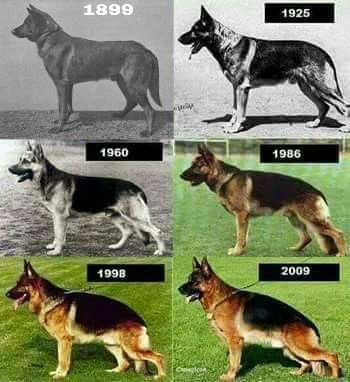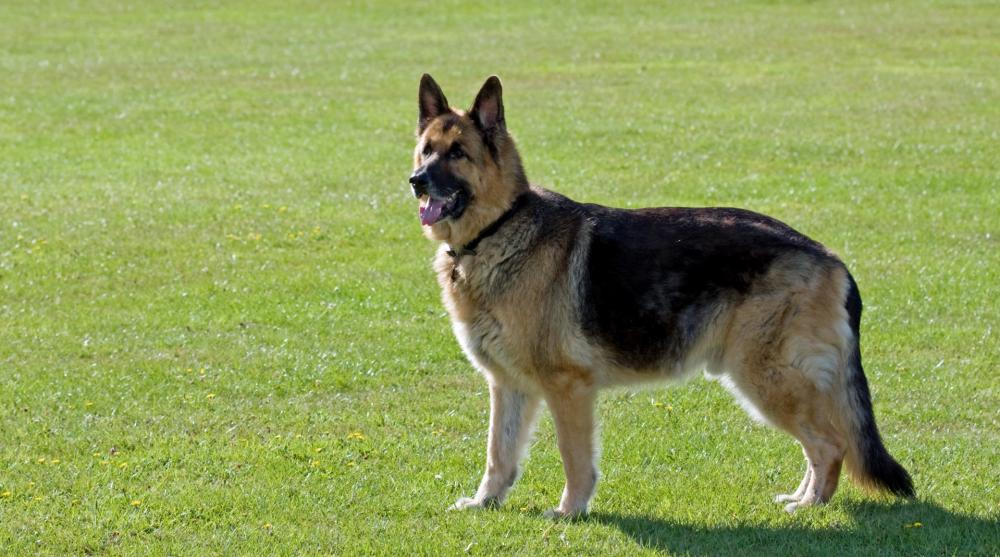German Shepherds - Research confirms the obvious??

 According to a press release from the University of Surrey in the UK:
According to a press release from the University of Surrey in the UK:
"Movement of German Shepherd Dogs is dependent on their shape".
Perhaps most people might first respond like I did, i.e. No Kidding!
I do not think it takes an anatomist or veterinarian or experienced dog person to think that the dogs in these images might 'move differently' and that it likely would have something to do with their shape.
But hey. We all try to find catchy titles for press releases. This one is to introduce new research from a group at the University of Surrey.
Table of Contents
Research on Movement and Posture of German Shepherd Dogs and Labrador Retrievers.
Biomechanical comparison of standing posture and during trot between German shepherd and Labrador retriever dogs
Humphries A, Shaheen AF, Gómez Álvarez CB (2020) PLOS ONE 15(10): e0239832. https://doi.org/10.1371/journal.pone.0239832
"This study provides a detailed quantitative description of the trotting movement and standing posture of the GSDs and LRDs
by presenting kinetic and kinematic parameters for each breed, together with conformation measures."
- (HINT: There are many many research and review articles on gait analysia, kinetics and kinematics. Feel free to Google. But, basically, knowing that these tests are done in labs with advanced equipment and analyses that yield objective, quantifiable, and repeatable information on normal and abnormal gait in dogs is probably enough to get you through this. For many more resources, videos and links, see Additional Resources, below.)
Locomotor Problems - GSDs and Labradors
I am sure the authors were not surprised that shape influenced gait. They say "It is widely accepted that canine breeds stand and move differently depending on their individual breed characteristics [1–3]. A number of pure canine breeds have a higher prevalence of common musculoskeletal disorders such as hip and elbow dysplasia [4,5]." [Note: See these and other references in the article from link above or PDF attached below.] The two breeds in this study are at high risk for both these conditions. See Demography and disorders of German Shepherd Dogs under primary veterinary care in the UK from our IPFD Collaborating Partner VetCompass, and the chart below from the Swedish Insurance Data.
Note that in these Life claims, GSDs had higher risk compared to All Breeds (yellow line) for death (euthanasia) due to hips and elbow than Labradors. Also note the marked higher risk for spinal problems (would include lumbosacral issues) in GSDs. See full Agria Breed Profiles for breeds.
"Conformation measures and resulting movement patterns have been previously reported", say the authors, and they go on the review the techniques and findings on conformational differences, in general, and between dogs with and without hip dysplasia. And make the point that kinetic measurements can show differences in dogs where lameness may not be obvious to an observer.
Research Design and Findings
What is particularly new in this research: "To date, there are no studies comparing GSDs and LRDs nor describing any breed in standing posture." ... "Objective descriptions of standing posture, gait and body morphology may be key in identifying links between mechanical and anatomical features. This will lead to an improved understanding of the consequences of combining features that may favour abnormal joint loading and therefore result in pathology over time."
The main goal of the research was to develop baseline parameters for standing and trotting, together with conformation measures and to compare between the breeds.
As I read to this point I was thinking... and what about differences within a breed - especially as there are considerable variations in conformation/type in each of these breeds? For GSDs and Labradors. In the Discussion, the authors clarify that they did not select on or differentiate between show and working lines, in either breed. This is unfortunate, as the study would have been much more impactful with that comparison.
Twelve dogs of each breed were recruited. And, as they only included dogs that were healthy and not lame, (and rightfully so!) they would likely not have recruited the most extreme dogs.
Findings:
We won't go into details here - their material is technical, but well-presented in the article. I would highlight this result. The GSD has increased flexion in the lumbosacaral joint (between the spine and the pelvis), which resulted in a greater incline of the lower back and increased pelvic tilt compared to LRDs. The GSDs had "more flexed hocks and stifles, extended hips and shorter tibias". You can see their figure 9 which shows the effect on the hind end of the GSDs compared to the LRDs.
Take Home Message
You cannot breed for a 'look' or appearance on the outside without changing what is on the inside!
Unfortunately - this may not be in the best interests of a sound dog.
The authors site a study by "Fischer and Lilje, 2014 in GSDs, where 10 GSDs from a working background and 14 GSDs with a background in the show ring were studied" which showed even shorter hind limb bones in the show line GSDs. Lumbosacral disease is known to occur at high risk in GSDs - and even if quantitative evidence is limited - it is not unreasonable to hypothesize that there would be some impact of the conformation/anatomy.
And, So?
Most breeders, especially of active or working breeds prioritize structure and movement in selecting dogs for breeding. Certainly, in the show ring, movement is an important criteria - in fact, observing the dog in motion comprises the majority of the judge's time and attention. Many of these breeders and judges will have a personal library full of books on canine locomotion and anatomy. Canine movement is exceptionally diverse and well-studied.
However, as we have seen for some - breeders, show hobbyists and owners - extremes in body conformation have become trendy or desirable. The research described in this blog was no doubt prompted by a situation at the Crufts dog show in 2016, when a GSD displaying extremely compromised movement was awarded Best in Breed. The dog's agitation was cited as a contributing factor, however, it seemed obvious to the public that the extreme curvature of this dog's back affected her ability to move and the spectacle that day was deemed unacceptable. Of course, those who prefer and promote the sloped conformation of latter-day show German Shepherds tend to claim there is no negative influence on them.
So we come to my mixed feelings on this research:
1. Well done research. Some concern about the number of dogs and the selection for them. Nice to see locomotion linked with conformation. This will support further work to address impacts of conformation on health.
2. Really? Do we need this level of proof when, if we are honest about what we observe and employ common sense we would acknowledge that the extreme conformation of many GSDs obviously and not surprisingly impacts their movement? I guess there are at least two questions: Does it matter? and Who decides?
So, we come again to where we have been before. Do people in favour of extremes of conformation "Don't know? or Don't Care" - see this blog, e.g.
Have they consciously decided that satisfying their ideals in terms of dog design is justified regardless of the impact on health or welfare, or a dog's ability to perform normal functions, activities and behaviours? Or do they simply feel that the impairment is unimportant or insignificant? Whatever the case, as we have seen with brachycephalic issues, it seems that more facts and research evidence do not necessarily convince them there are problems.
But at least, research like this gives those trying to make improvements more evidence for their claims. Identifying the most deleterious characteristics which affect health and welfare of breeds and working towards breeding healthy dogs, in the long run, will benefit both dogs and the people who love them.
PDF of original research : Shape influences biomechanics U of Surrey Oct 2020.pdf
Additional resources:
-
At the 2nd IDHW we had a session on movement with German expert Martin Fischer (referenced in the article): see Dogs in motion: Interdependencies of skeleton, muscles and locomotion: 2nd IDHW: Abstract: https://dogwellnet.com/files/file/141-plenary-talks-2nd-idhw-dogs-in-motion/
-
More on locomotion in canines:
- Standards, Health and Genetics in Dogs - Chapter I - Gait, movement and related characters in various selected breed standards - Martin S. Fischer (Germany) 1.0.0
-
For a write-up on The Jena Study referenced in Pr. Fischer's section of this book see: https://www.uni-jena.de/en/News/Archiv/Archiv+2011/PM110527_Hundestudie_en.html
- This Nordic 2017 symposium PDF has a really nice write up on Martin Fischer's work - has some details...
-
For further information available on the VDH's website see "Dogs in Motion" : https://www.vdh.de/en/shop/dogs-in-motion/
Prof.Dr. Martin S. Fisher from Jena University in Germany has presented the results of the most extensive study worldwide concerning the motion of dogs and demonstrated precise insights into their course of movement for the first time. Prof. Fisher's book Dogs in Motion explores the locomotion of dogs in a highly scientific yet easily accessible manner. An innovative illustrative style brings the dog anatomy to life and makes clear the way in which the skeleton, the muscles, and locomotion fit together. Based on the results of the largest-scale study on the subject ever carried out, an experiment that involved over 300 dogs and 32 different breeds, the book delivers completely new insights into the motion sequences performed by dogs. The accompanying DVD (without sound-files) features over 400 movies, X-Ray movies and 3D animations and demonstrates both the variety and uniformity of dog locomotion with unparalleled precision and clarity.
-
More on locomotion in canines:
- Video of Breed Judging for GSD at Crufts in 2016: https://www.youtube.com/watch?v=QBq6gM0sI7A
 Donate
Donate



0 Comments
Recommended Comments
There are no comments to display.